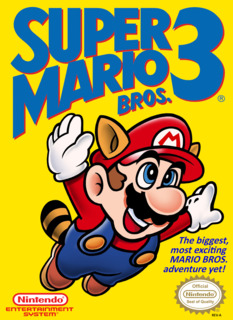Twenty years later, Super Mario Bros. 3 is still an exceptional plat-former, proving it to be a timeless masterpiece.
Super Mario Bros. 3 graced the Nintendo Entertainment System twenty years ago. After an odd departure in Super Mario Bros. 2 from the formula in Super Mario Bros. that singlehandedly created the platforming genre, made Mario a household name, revitalized the gaming industry, and made Nintendo a force, Super Mario Bros. 3 was a return and perfecting of the original Super Mario Bros. formula.
It was only the second time that Bowser had kidnapped Princess Peach from her castle in the Mushroom Kingdom. The King of Koopas did more than steal the Mushroom Kingdom's princess this time around however. Seven other kings of different lands had been transformed into creepies, crawlies, beasts, and reptiles by Bowser's kinfolk. It is up to Mario to travel to these kingdoms and restore order by defeating Bowser's minions, restoring the kings to their normal selves and rescue Princess Peach.
Mario, for a plump, over-all wearing fella, can jump high and far. But his astounding jumping abilities were not the only thing that he had to help him through his tough journey this time. The fire flower which gave Mario the ability to throw fireballs made a return, along with some of the series best, most memorable power-ups. There is a frog suit that enhanced Mario's swimming skills, a hammer suit that gave Mario hammers to throw like a hammer brother, and a leaf that made Mario grow a pair of furry ears, a raccoon tail, and gave him the ability to fly.
Each of the eight worlds that Mario had to travel through were all unique. Whether it be sliding across ice, swimming in the sea, running across green plains, navigating through pipe mazes, scaling pyramids, or jumping across pits of lava, each world introduced new obstacles within its stages, which helped keep the experience fresh. Each world usually contained 10-12 stages (that includes the castle stages). The player moved Mario on a map from one stage to the next. Many of the stages contained hidden areas and items, which added replay value and gave the gamer a good reason to carefully explore the stages in hopes of discovering goodies. Discovering hidden items and areas within the stage rewarded the player with a great sense of exploration.
Super Mario Bros. 3 remains the best looking, sounding game ever released for the Nintendo Entertainment System. Its art direction takes the weird and wacky style of the original game and turns it up a few extra notches. Detailed hills were visible in the backgrounds and clouds glided across the skies. The sea was alive, containing fish, jellyfish, coral, all incredibly detailed for an 8-bit game. Character sprites were colorful and exceptionally animated. Every tune was catchy in Super Mario Bros. 3, but also instrumentally sound and artistically innovative in gaming music. The piano and bass work were especially impressive as the core instruments in many of the game's vibrant tunes.
Super Mario Bros. 3 was the greatest game to ever grace the Nintendo Entertainment System. With it, Nintendo continued to evolutionize a genre that they singlehandedly created with the first game in the franchise. Such diversity in the context of power-ups, level design, graphics, and music had never been seen in a game before Super Mario Bros. 3. It became the blueprint and standard for 2D platformers after it to be measured against. Simply put: Super Mario Bros. 3 is a timeless masterpiece that should be experienced by every generation of gamers.

